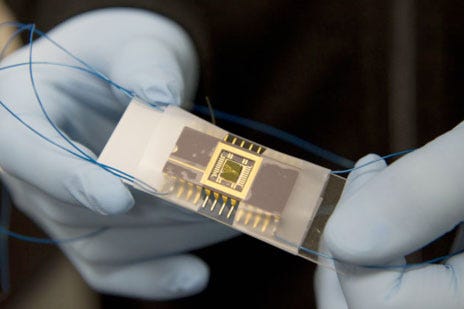How Light-based Electronics Could Rev Up Computers
March 3, 2014
|
Optoelectronic device made of silicon and carbon nanotubes (Courtesy Northeastern University) |
Two Northeastern University (Boston) professors have combined their expertise to make a discovery that may help future-generation computers and other electronics run even faster.
Assistant professor of physics Swastik Kar, PhD, and Yung Joon Jung, PhD,an associate professor in the department of mechanical and industrial engineering, have published a paper in Nature Photonics that describes the devices they have built that make use of their discovery.
Both are interested in graphene, which is carbon atoms linked in a crystalline structure one atom thick. Kar studies the physical properties of graphene, while Jung focuses on carbon nanotubes, which are made of graphene in a tubular configuration.
In 2012 the pair made the discovery that when light hits a photodiode made of silicon and graphene nanotubes, the resulting photocurrent can be controlled by an applied voltage. They received a National Science Foundation grant to explore the phenomenon, which they discovered entirely by chance.
In proceeding with these studies, they discovered that the rise time of these currents in carbon nanotube and silicon devices is much faster than that of traditional photodiode devices made of silicon and a metal.
"That sharp rise helps us design devices that can be turned on and off using light," Kar said. "People believe that the best computer would be one in which the processing is done using electrical signals and the signal transfer is done by optics,"
So the pair began making devices that would show whether the phenomenon had practical applications. They fabricated an array of 250,000 photoactive elements on a 1-cm-square wafer, like the pickup element of a digital camera.
To prove usefulness in a computer, the duo also made bidirectional phototransistors and novel clock-triggerable logic elements, including a mixed optoelectronic AND gate, a 2-bit optoelectronic ADDER/OR gate, and a 4-bit optoelectronic digital-to-analog converter. Those devices, which are the first to integrate electronic and optical properties on a single electronic chip, represent a critical breakthrough in making this computer of the future a reality.
The scientists say that their discoveries could lead to a new generation of extremely efficient electronics.
Stephen Levy is a contributor to Qmed and MPMN.
About the Author(s)
You May Also Like


.png?width=300&auto=webp&quality=80&disable=upscale)
